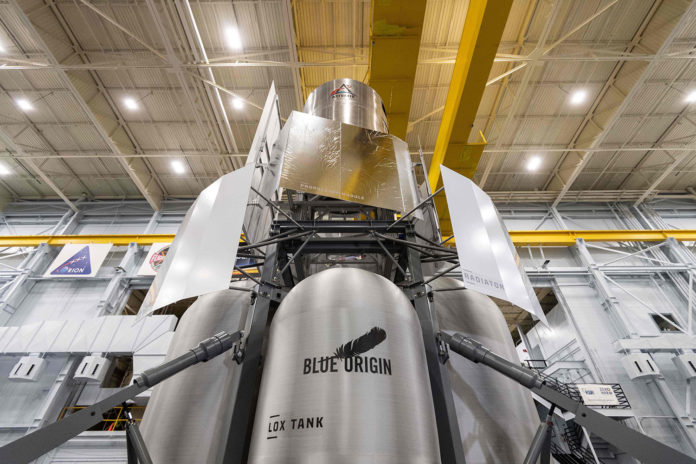The Blue Origin-led Human Landing System (HLS) National Team – comprised of Blue Origin, Lockheed Martin, Northrop Grumman, and Draper – has developed a full-scale engineering mockup of a crew lander vehicle that could take American astronauts to the Moon. The team has already delivered it to NASA for analysis and review. The lander is set up in the Space Vehicle Mockup Facility (SVMF), NASA Johnson Space Center’s (JSC) iconic Building 9.
The lunar lander, standing at more than 40 feet, is the Blue Origin National Team’s update to Apollo’s Lunar Module (LM). The full-scale prototype consists of two elements of the National Team’s multi-element architecture – the Ascent Element (AE) and Descent Element (DE). It will be used to validate the National Team’s approaches for getting crew, equipment, supplies, and samples off and on the vehicle.
The DE is based on Blue Origin’s Blue Moon cargo lander and BE-7 LOX/hydrogen engine, both in development for more than three years. It is autonomous and can land without the need for a human pilot, so it can also be used as an independent unmanned spacecraft for an earlier demonstration landing, and also for bringing large cargo payloads to the lunar surface.
The AE incorporates avionics, software, life support hardware, crew interfaces, and mission operations from Lockheed Martin’s human-rated, deep-space Orion vehicle that will fly on the Artemis I and II missions. A consistent cockpit experience and training from Orion to the AE makes the end-to-end mission safer for Artemis.
Based on Northrop Grumman’s Cygnus vehicle that provides logistics resupply to the International Space Station, the Transfer Element is a propulsive stage that starts the lander on its descent trajectory from lunar orbit.
Blue Origin says the mockup will remain at JSC through early 2021 for a series of tests and simulations. Over the coming months, the National Team will continue to build and increase mockup fidelity. In collaboration with NASA organizations, including JSC’s Astronaut Office, the team plans to perform engineering and crew operations tests with astronauts aiming to fly the final system within several years.
“Testing this engineering mockup for crew interaction is a step toward making this historic mission real,” said Brent Sherwood, vice president of Advanced Development Programs, Blue Origin. “The learning we get from full-scale mockups can’t be done any other way. Benefitting from NASA’s expertise and feedback at this early stage allows us to develop a safe commercial system that meets the agency’s needs.”
The Blue Origin National Team – along with two other companies, SpaceX and Dynetics – won the first round to design and develop human landing systems (HLS) for the agency’s Artemis program that aims to put humans back on the Moon in 2024. Currently, they have time to refine their systems. Later, the agency will review them again and then make a decision about choosing a particular one.
